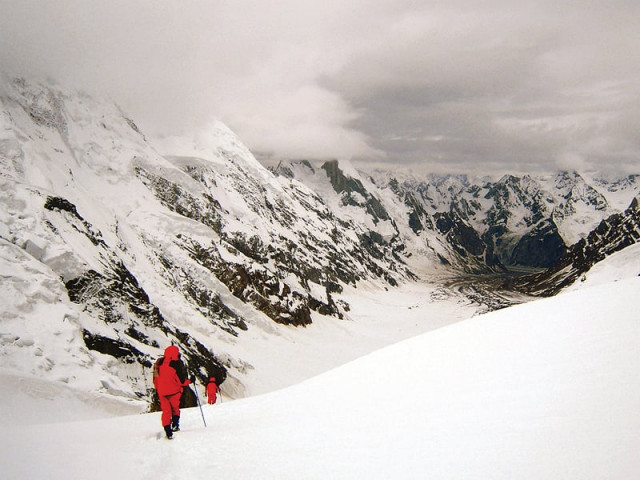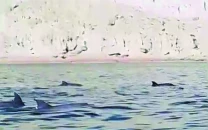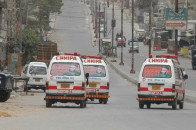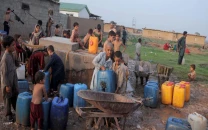Mountain climbing: Gods awaiting pilgrims
With towering peaks that even the Swiss would envy, Pakistan is a mountaineer’s paradise.

With towering peaks that even the Swiss would envy, Pakistan is a mountaineer’s paradise. If serious efforts are made to boost tourism in the Northern Areas, the destiny of the entire region could change for the better . PHOTO: VASIQ EQBAL
These are some of the more printable replies I got when I declared, with much fanfare, that I was about to embark on an expedition to K-2. Of course, not all the replies were as demotivating as these, but even the somewhat supportive ones were laced with caution, sheer terror (for my expected fate) and had the ring of a final goodbye.
Going to K-2 had always been a dream of mine. Of course, it was a dream that I had seen while sitting in the comfort of my cozy drawing room, without really thinking it would happen — and that too so soon. So when the day finally arrived I blithely opted to fly to Skardu, treating myself to in-flight meals and a beautiful bird’s-eye view of the Karakorum. Little did I know that this would earn me the undying hatred of the expedition manager Fareed Gujjar. As it turned out, I was the only one lucky enough to bag a seat, while the others had to suffer through a 36-hour drive through the twists and turns of the Karakorum Highway (KKH). My attempts to pin this on the vagaries of the national carrier were to no avail, and for the rest of the trip, Mr Gujjar’s taunts were no less biting than the cold itself. Before I go on about the expedition itself, I have to send a shout-out to Zahid Ali Khan aka ZAK, a humble and brilliant photographer who captured the stunning vistas you’re looking at here. Despite being 50 years old, overweight and diabetic, and having no mountaineering experience whatsoever, he took on the Karakorum where a lot of younger and healthier men faltered.

The first day started with a jeep ride from Skardu to Askoli Valley, our first camping site and the last human settlement in that area. The six-hour long, and very bumpy, ride was really tiring but I thought better of opening my mouth to complain when I saw that Gujjar’s anger over my plane ride had not yet subsided.
When we reached Askoli however, all the exhaustion was forgotten. A dazzling and awe inspiring valley, Askoli is a kaleidoscope of colours. Mountains of blinding white tower over fields of lush green grass; yellow sunflowers huddle around huge black rocks. From there we hopped from one camp to another, until the vast and terrifying wilderness of the Baltoro glacier stretched out before us. It’s long and dotted with ridges, crests and troughs, which made us rename it from bal-toro to haddi-toro (bonebreaker). The Karakorum range, also called the third pole, is one of the most heavily glaciated regions in the world and its 135 glaciers are a crucial water source for the arid low-lying areas.

After crossing Baltoro with our bones mostly intact, it was off to Concordia. On the way — through a cleavage between two smaller peaks — I caught a glimpse of Chogori, as K-2 is locally called. The first sight of my dream destination left me spellbound, but then a cloud descended, as if a veil had been lowered over the face of a blushing bride, and the moment passed. Not a veil, I thought again, but perhaps a crown for the King of the Karakorum.
And why not? K-2 — apart from being the world’s second highest peak — is also one of the three Pakistani ‘eight-thousanders’ (peaks over 8,000 metres in height) that remain unclimbed in winter. Gasherbrum II and I were recently climbed in the winters of 2011 and 2012, respectively, leaving only K-2, Broad Peak and Nanga Parbat in this exclusive club. None have successfully scaled their heights in winter, and these three remain an irresistible challenge to mountaineers everywhere.

And then there is Concordia. It got its name from European explorers, thanks to its similarity to another glacial confluence, know to the Swiss as Konkordiaplatz.
To me it was like a beautiful castle, the cornerstones of which are the Godwin-Austen and Baltoro glaciers where four towering eight-thousanders stand as if to defend it. The flanks of this natural fortification are secured by the Marbel and Mitre peaks.
Concordia is that bastion of mighty mountains which lures climbers from all over the world. Galen Avery Rowell, a noted wilderness photographer and climber termed Concordia “The Throne Room of The Mountain Gods”. A fitting title indeed.
But the Government of Pakistan has neglected these lonely gods for too long. To understand the level of this neglect, one must compare our eight-thousanders with those of other countries. There are only 14 eight-thousander peaks in the world, all of them located in South Asia.
India’s only eight-thousander, Kangchanjunga is shared with Nepal. In the same way, the four on the Nepal-China border — Mount Everest, Lhotse, Makalu and Cho Oyu are also shared.
Dhaulagiri, Manaslu and Annapurna 1 (8,091m) are entirely in Nepal, whereas Shishapangma the shortest of eight-thousanders, is wholly in the Tibetan Autonomous Region of China.
In a nutshell, six are divided between four countries, one is entirely in China, and Nepal has three. So with four of these giants (Gasherbrum I & II, Broad Peak and Nanga Parbat), Pakistan is in the lead. Even K-2, which borders China, is best accessed from Pakistan and is considered a more challenging climb than even Everest. Pakistan is a mountaineer’s paradise but no effort has been made to exploit this bounty of nature.

In fact, even the simple task of installing toilets here fell to an Italian NGO. When we arrived at Concordia, we found that they had installed eight eco-friendly toilets and had even devised a mecanism to dispose of human waste. They transport the excrement in drums via porters down to an earth incinerator, a process that takes three days. While the Pakistan government does lend its support, it was the Italians that took the initiative. They also carried out a K-2 cleanup operation, collecting 802 kg of disposed climbing gear.
When night falls in Concordia, the light from infinite stars travels down from the heavens to illuminate the ice under your feet. In the day, the practically unfiltered UV rays scorch your exposed skin and by night, the bitter cold makes you shiver.

From there we went off to try and get to the Gilkey memorial in the foothills of K-2. This is a cenotaph cairn erected and named after Art Gilkey, an American mountaineer who died at K-2 in 1953. The place is a memorial of those who have died while struggling with this savage mountain.
By this time, the whole group was so exhausted that only six out of the total 18 dared to go further. And out of those six, four decided to stay at K-2 base camp. Now it was just me and an ardent trekker named Dr Shahid, whose nightly snoring I felt sure would bring the mountains down upon our heads.
Creeping, crawling and sometimes crying with fear and exhaustion, we kept our spirits up by singing “ ” and somehow managed to cover a distance of four days in just 15 hours. After crossing a couple of hanging and hair-thin ice bridges with only the light of our headlamps to guide us, we made it back to Concordia with a light drizzle falling on us.
The trek to the memorial was terrifying and tiring but the view of all Concordia, the K-2 base camp, Angel Peak and a nearby lake was worth sacrificing our only Rest Day.

Photo credit: Zaigham Islam
Of course, nature then gave us not one but four rest days by stranding us at Ali camp, thanks to sudden snowstorms. Then came the zenith of our expedition: Gondogoro La, the world’s highest crossable (but very avalanche prone) mountain pass. It’s not just the height of it, a sickness-inflicting 5,940 meters that’s the problem, but the 50 degree slopes you have to ascend and descend as well.
Worse yet, an avalanche the night before had buried the defined path and it was nothing less than a miracle that we, who were mostly photographers and not professional climbers, made it through without injury.
Finally, there came our reward: the sight of all the 8,000m peaks of the Karakorum illuminated by the rosy-fingered dawn. No words can describe it. No picture can define it. And somehow, Pakistan cannot take advantage of the bounties nature and geography have bestowed on us.

What could we gain were we to fully tap into the mountaineering market? Let’s take the example of Switzerland — famous for its alpine sports and treks — where in 2011 tourism accounted for an estimated 2.9% of Switzerland’s gross domestic product. Tourism accounts for around 150,000 full time jobs in the country, the highest peak of which is barely 5,000 metres!
But perhaps Switzerland is too distant and developed to serve as a good comparison, so let’s look at India. Our neighbour-cum-foe has made tourism its largest service industry, and it now accounts for 6.23% of its GDP and 8.78% of its total employment.
In Nepal, Pakistan’s strongest competitor in terms of eight-thousanders, tourism is the largest industry, so big that it’s divided into three sections: culture, adventure and ecotourism. Nepal considers the tourist industry key to alleviating poverty and to achieve greater social equity.
Another contender in the race of eight-thousanders, China — possessor of half of K-2 and half of Mount Everest — is the third most visited country in the world, despite the language barrier. China’s tourism revenue reached $185 billion in 2009.
Then there’s Pakistan. Last year, 18 climbing and mountaineering expeditions — a total of 120 climbers — were likely to visit Pakistan. According to an unofficial account, just 30 climbers summited the K-2 this year. In an interview one of them said “Karakoram puts the rest of the world’s mountain ranges to shame.” We are sitting on a gold mine of mountains but getting only 120 explorers a year. Now that’s a real shame. 9/11, Talibanisation and terror brought Pakistan’s tourism industry to its knees, but the recent crises and sectarian massacres have truly put it on the mat. After the 2005 earthquake, Lonely Planet called Pakistani tourism ‘The next big thing’. The Guardian even released a list of “Top Five Tourist Sites in Pakistan”, but none of this promotion was effectively used by the government. By 2008, the World Economic Forum’s Travel and Tourism Competitiveness Report (TTCR) ranked Pakistan at a dismal 103 out of 124 countries to visit. Now, the number of tourists falls every year due to a lack of security and infrastructure. Even the step of waiving royalty charges for peaks up to 6,500m, and giving large discounts for other peaks had little effect. In my opinion, it’s not the discount that’s the problem but the utter lack of security that keeps foreign climbers away. Adventure tourists, trekkers and climbers are a hardy lot who can do without spas and hotels. But they can’t do without security.
Last August, a bus full of passengers was massacred at the Babusar pass, compelling security forces to close down the KKH, the only ground link of Gilgit-Baltistan (G-B) with the rest of the country. More than 120 stranded foreigners were then airlifted from G-B to Islamabad. Assuming that those 120 foreigners will only sing praises of G-B’s landscape (if they were lucky enough to have had a glimpse before the tragedy), would be a cardinal mistake. It is after all a marketing maxim that a happy customer tells three people while an unhappy customer tells 300!!
Porterage is the life blood of the people of the mountainous regions. That is how local breadwinners manage to feed their families. A porter in the Northern areas of Pakistan earns less than $5 a day for carrying heavy loads 25kg across treacherous terrain and deadly paths, wearing only one layer of clothing and plastic chappals. If the number of tourists declines further, these people will be pushed to the brink. And desperate people are dangerous people.
Writer Harvey Voge once said that “The mountains will always be there, the trick is to make sure that you are too”. Yes, the mountains will always be there, but that doesn’t mean we can wait around forever before taking the needed steps to make sure that others can get there too!
Published in The Express Tribune, Sunday Magazine, January 27th, 2013.
Like Express Tribune Magazine on Facebook to stay informed and join the conversation.


















COMMENTS
Comments are moderated and generally will be posted if they are on-topic and not abusive.
For more information, please see our Comments FAQ